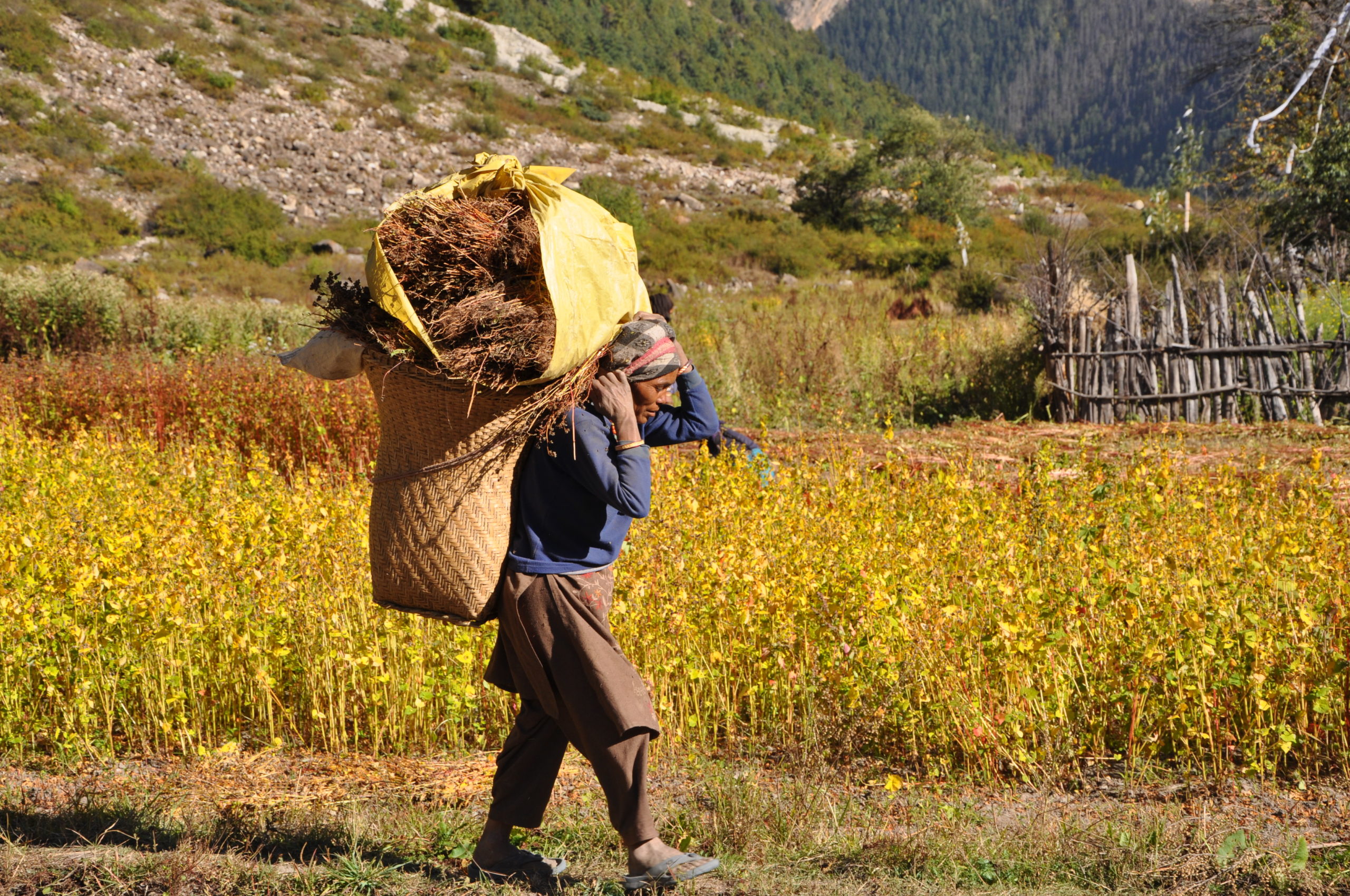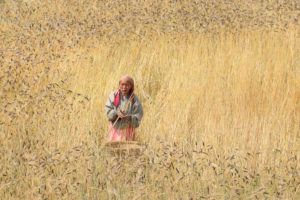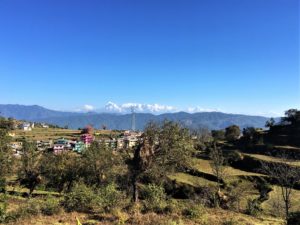By Aubrey Schoff, Western Colorado University, USA & Kuldeep Joshi and Prikyanka Adhikari, G.B. Pant National Institute of Himalayan Environment, India
“If we [do] not follow the rule [to] stay at home, COVID-19 [will] affect me, my family, and Majkhali. Prevention is better [than a] cure so stay home…stay healthy” said Shivani Adhikari, a 20-year-old villager living in rural Majkhali, India, nestled in the foothills of the Himalayas. Shivani was attending college six days a week and tutoring local children before the pandemic hit India. Now, she is home with her father, mother, grandmother, and aunt, tending to their crops planted just a few months ago.
The Indian Himalayan Region (IHR) covers nearly 537,000 km2 which is about 16 % of India’s total geographical area and approximately the same size as the entirety of Central America. The IHR extends through 11 states. These states consist of many mountain communities with various traditional systems and rich cultures, and the 2011 census demonstrated that the majority of these states’ populations live in rural areas. The major problems in most mountainous regions are the lack of education, medication, and employment facilities. Lack of these amenities/services are the major causes of migration from IHR mountain regions to the urban areas, as people pursue access to better jobs and education. People work in urban areas and persist through tough living and working conditions to send money back to their families.
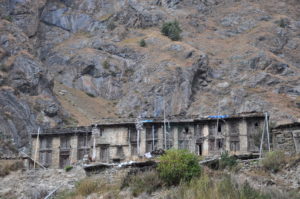
A vacant home sits beside an impressive mountain slope in rural India; this home was either unfinished or abandoned as those in rural India migrated to the city (photo: Kuldeep Joshi).
Due to fear of the COVID-19 pandemic, people originally from mountain communities are coming back to their native villages. This is an increasing trend which brings both happiness and sorrow as many families haven’t been reunited in a long time, but the unfortunate and scary circumstances of COVID-19 make these reunions difficult. “Villagers are scared of any outsider coming [to the rural areas] as they feel that if in case COVID-19 spreads here they will not be able to get medical aid and this may result in [a] complete wipe out of a village.” Namratha Suri explained, a community member living near Majkhali India. Permanent villagers are refusing to welcome migratory villagers due to the threat of COVID-19, treating them as hosts of the corona virus, and taking them as a curse for the villagers. There is a need to change this “threat mentality” that permanent residents have of migratory villagers, and instead move to a “solution mentality” whereby migrant villagers with a thorough medical examination can enter safely and without prejudice from permanent residents. Government agencies, NGOs, and local workers are working to prevent migration back to mountains, as this movement of people threatens not only the health of rural mountain people, but also their traditional identity and behaviors.
Yet, people do not feel safe in cities with rising COVID-19 cases and degrading living conditions. Recent data indicates that higher numbers of people are infected in urban areas and large towns compared to rural and rural mountains town and villages. Namratha, although from the mountains, usually travels to the larger cities often for work or personal obligations. “[A] few areas in [the] big cities have been locked down…they are not ever allowed to go outside for food [or] essential[s]. So that has created panic,” she stated.
Mountains communities in the IHR are usually lively places, but have had to make changes as precautionary measures in response to the pandemic. However, they are still significantly less affected compared to the urban areas, often with no cases at all. In the mountains many newly selected village presidents are young, well-educated, and very alert for these kinds of emergency situations. Village presidents have ensured the sanitization of their villages and spread of general awareness between villagers for protecting themselves from pandemic. In some locations, daily wage laborers are suffering immensely, unable to fulfill their daily needs and livelihood requirements due to lockdown orders in the country. Government agencies are providing food and daily goods for reachable villages to offset these food insecurity issues. “As most of the villagers work on daily wages it is [really] effecting their income,” said Namratha. “But government is providing [the] best support to them by providing [a] ration (rice, sugar) which they get on [a] monthly basis on [a] nominal rate. [Some days], they get two months ration in advance. Government is doing its best to handle the situation even though we have limited resources.”
Other village communities do not fear COVID-19 and are living their lives as normal, typically those who are far away from the modern amenities of towns and facilities and still fully dependent on their subsistence agriculture and traditional health care systems. “…in the hills people have [to] farm, graze cattle and goats, [and collect] grass and wood so they have to move around Majkhali” Namratha explained in response to stay-at-home quarantine orders by the Indian government. “Ranikhet, [a nearby city], is only open from 7 AM to 1 PM otherwise it is completely shut down, no movement allowed after that. All state borders are also closed so no one can come in our go out.” These lockdown orders are not realistic given the dependence of rural mountain communities on subsistence activities for survival.
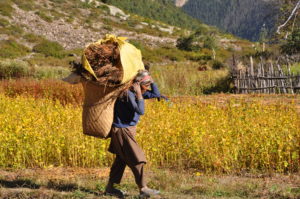
A woman in rural, mountainous India walks back to her home with collected forage for use in the home. (photo: Kuldeep Joshi).
The Tourist District of Himalaya, although mostly untouched by the virus, is suffering a lot from the lockdown. There were hopes for sustained work for those living in the region, but the pandemic has shattered everything. There is hardly any work at the moment except some menial labor. Local business, shopkeepers, and daily laborers are highly affected. Streets are almost empty. Fewer and fewer people are coming to purchase items in the limited hours markets are open. Many businesses are dependent on metro and developed cities and towns to continue operations so the effect to all business is tremendous.
Despite these challenges, mountain villagers’ capacity to deal with the crisis is very high. For example, the lockdown caused many workers and villagers to get stuck away from home, and new places have opened where they can live until the lockdown ends. At this point, any action the government takes is likely going to be seen in a positive light. The government has opened a care fund, which provides money to needy people across all of India. In addition to the national government, state governments and NGOs are also contributing food and shelter for the needy peoples.
Before COVID-19, the mountains were seen as undesirable places to live due to the lack of facilities and services. But COVID-19 has created many unlikely happy reunions in vacant houses in these mountains, despite the fear and uncertainty that comes with it. The majority of people are now ready to return to their native mountain homes, where life has continued largely unaffected by the pandemic. It will be very interesting to see how this situation changes in the coming months!

